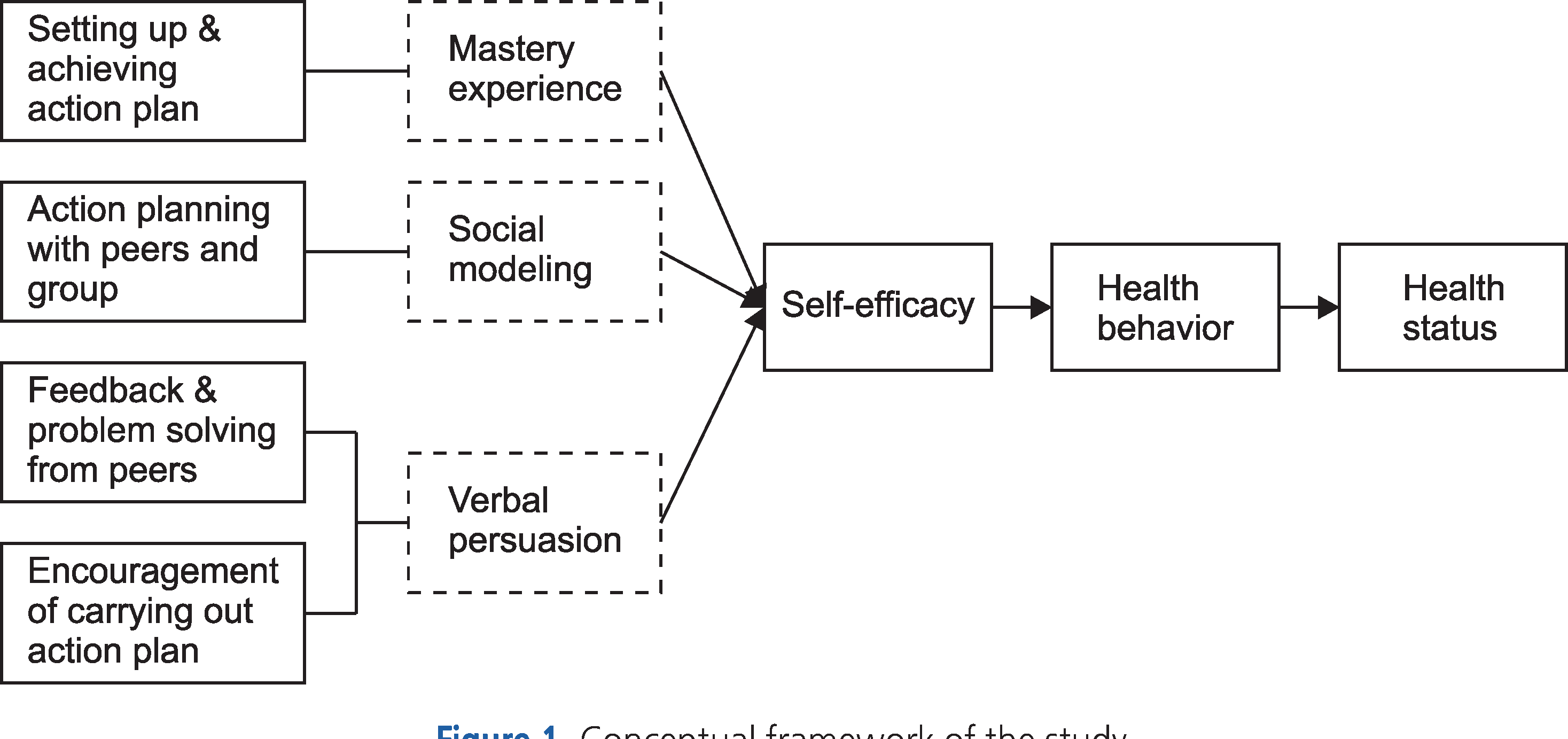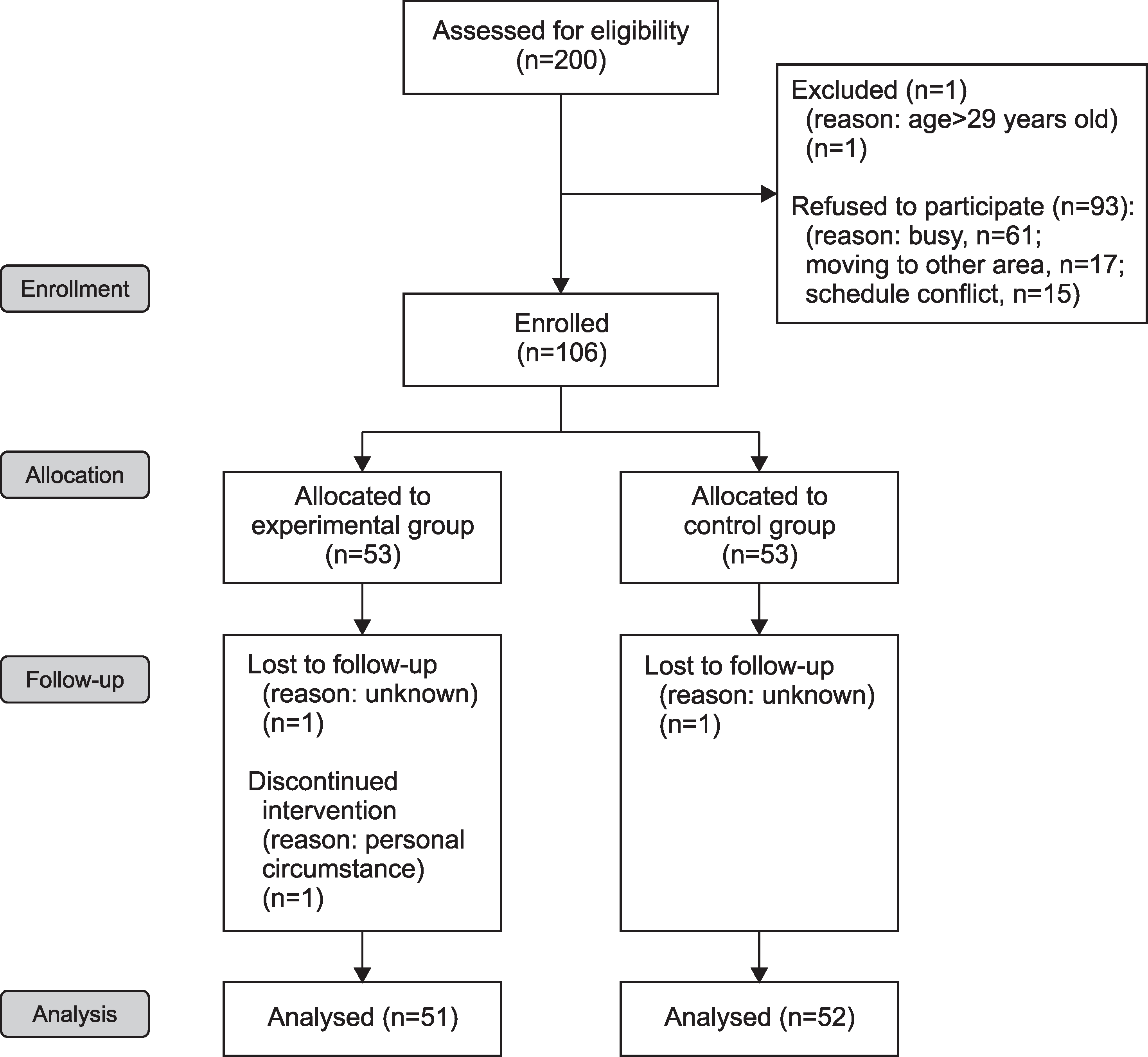Abstract
Purpose
The purpose of this study was to evaluate the effectiveness of a health promotion program utilizing action planning strategy for young adults.
Methods
A non-equivalent control group pre-post-test design was used. One hundred three university students participated in the study. Participants in the experimental group (n=51) were provided the health promotion program utilizing action planning strategy for five weeks. The program consisted of weekly sessions that included action planning and group feedback. The control group (n=52) was provided with health information every week for 5 weeks. Program outcomes, including self-efficacy, physical activity health behaviors, total exercise time per week, daily cigarette consumption, frequency of alcohol drinking per month, nutritional health behaviors, and subjective health status, were assessed at baseline and at follow-up after 5 weeks.
Results
The participants in the experimental group demonstrated significant increases in self-efficacy, physical activity health behaviors, weekly exercise time, and nutritional health behaviors and significant decreases in daily cigarette consumption than those in the control group.
Conclusion
The health promotion program utilizing action planning strategy is a brief and effective intervention to promote health behaviors among young adults. Further investigation is warranted to assess the program's effectiveness among other age groups and populations at high risk for chronic illness.
Go to : 
References
1. Korea Centers for Disease Control & Prevention (KNHANES). 2015 Health behavior and chronic disease statistics: Korea National Health and Nutrition Examination Survey (KNHANES VI-3) and youth health behavior online survey. Cheongju: KN-HANES;2016. Report No.: 11-1352159-000313-01.
2. Korea Health Promotion Institute. Health plan 2020, 2016-2020. Sejong: Ministry of Health and Welfare;2015. Dec. Report No.: 11-1352000-000285-13.
3. Park YR, Wee H, Kim SJ. Lifestyle, depression, and health related quality of life among women in Jeju province. Journal of Korean Academy of Community Health Nursing. 2010; 21(2):148–155. https://doi.org/10.12799/jkachn.2010.21.2.148.

4. Lee HJ, Jung EH. Socioeconomic status and elderly health in life course perspective: Testing of multi-mediational effects of socioeconomic status in early adult and middle aged. Health and Social Welfare Review. 2016; 36(3):53–84. https://doi.org/10.15709/hswr.2016.36.3.53.
5. Kim JH, Park EY, Lim KC. Self-reported realities of health behavior of undergraduate students after web-based health promotion education: Qualitative content analysis. The Journal of Korean Academic Society of Nursing Education. 2012; 18(3):413–423. https://doi.org/10.5977/jkasne.2012.18.3.413.

6. Yoo SH, Kim HK. Program theory evaluation of a lifestyle intervention program for the prevention and treatment of metabolic syndrome. Korean Journal of Health Education and Promotion. 2010; 27(4):165–175.
7. Kim JA, Kim SL, Jung HS. The effects of tailored life style improvement program for the hypertensive workers provided by occupational health nurse. Korean Journal of Occupational Health Nursing. 2009; 18(2):242–251.
8. Min SY, Paek KS. The effects of a health education program on health promoting behavior and self-efficacy in university students. Journal of Korean Academy of Community Health Nursing. 2007; 18(4):562–571.
9. Kang ES, Kim YH, Lee KR. The effect of holistic health program on spiritual well-being and mental health in nursing students. Journal of the Korea Academia-Industrial cooperation Society. 2011; 12(5):2172–2179. https://doi.org/10.5762/KAIS.2011.12.5.2172.

10. Park BN. Effects of the tailored exercise program on health and life satisfaction in college students. Journal of Health Informatics and Statistics. 2007; 32(1):49–70.
11. Kim HK, Kim YS. The effects of smartphone application to increase physical activity among university students. The Korean Journal of Physical Education. 2012; 51(5):457–466.
12. Bodenheimer T, Davis C, Holman H. Helping patients adopt healthier behaviors. Clinical Diabetes. 2007; 25(2):66–70. https://doi.org/10.2337/diaclin.25.2.66.

13. Howcroft M, Walters EH, Wood-Baker R, Walters JAE. Action plans with brief patient education for exacerbations in chronic obstructive pulmonary disease. The Cochrane database of systematic reviews. 2016; 12:CD005074. https://doi.org/10.1002/14651858.CD005074.pub4.

14. Gatheral TL, Rushton A, Evans DJW, Mulvaney CA, Halco-vitch NR, Whiteley G, et al. Personalised asthma action plans for adults with asthma. The Cochrane database of systematic reviews. 2017; 4:CD011859. https://doi.org/10.1002/14651858.CD011859.pub2.

15. Sniehotta FF, Schwarzer R, Scholz U, Schüz B. Action planning and coping planning for long‐term lifestyle change: Theory and assessment. European Journal of Social Psychology. 2005; 35(4):565–576. https://doi.org/10.1002/ejsp.258.

16. Lenzen SA, Daniëls R, van Bokhoven MA, van der Weij-den T, Beurskens A. Disentangling self-management goal setting and action planning: A scoping review. PLoS One. 2017; 12(11):e0188822. https://doi.org/10.1371/journal.pone.0188822.

17. Benyamini Y, Geron R, Steinberg DM, Medini N, Valinsky L, Endevelt R. A structured intentions and action-planning intervention improves weight loss outcomes in a group weight loss program. American Journal of Health Promotion. 2013; 28(2):119–127. https://doi.org/10.4278/ajhp.120727-QUAN-365.

18. Erasmus V, Kuperus MN, Richardus JH, Vos MC, Oene-ma A, van Beeck EF. Improving hand hygiene behaviour of nurses using action planning: A pilot study in the intensive care unit and surgical ward. The Journal of Hospital Infection. 2010; 76(2):161–164. https://doi.org/10.1016/j.jhin.2010.04.024.

19. Bandura A. Self-efficacy: The exercise of control. New York: W. H. Freeman;1997. p. 1–604.
20. Faul F, Erdfelder E, Buchner A, Lang AG. Statistical power analyses using G*Power 3.1: Tests for correlation and regression analyses. Behavior Research Methods. 2009; 41(4):1149–1160. https://doi.org/10.3758/BRM.41.4.1149.

21. Williams SL, French DP. What are the most effective intervention techniques for changing physical activity self-efficacy and physical activity behaviour—and are they the same? Health Education Research. 2011; 26(2):308–322. https://doi.org/10.1093/her/cyr005.

22. Naver. Naver Office: Introduction to Naver form [Internet]. Seongnam: Naver;[cited 2018 Aug 11]. Available from:. http://office.naver.com/userGuide.nhn?level1=form.
23. Becker H, Stuifbergen A, Oh HS, Hall S. Self-rated abilities for health practices: A health self-efficacy measure. Health Values: The Journal of Health Behavior, Education & Promotion. 1993; 17(5):42–50.
24. Choi JM, Moon IO. The effects of college students’ self-efficacy on their health promotion behavior. The Journal of the Korean Public Health Association. 2005; 31(2):105–113.
25. Walker SN, Sechrist K, Pender N. Health promoting lifestyle profile II [Internet]. Omaha (NE): College of Nursing, University of Nebraska Medical Center;c1995. [cited 2019 Jan 15]. Available from. https://www.unmc.edu/nursing/faculty/health-promoting-lifestyle-profile-II.html.
26. Walker SN, Hill-Polerecky DM. Psychometric evaluation of the health-promoting lifestyle profile II. Unpublished Manuscript, Omaha (NE): University of Nebraska Medical Centre;1996. p. 1–30.
27. Kim SH. The association between expectations regarding aging and health-promoting behaviors among Korean older adults. Journal of Korean Academy of Nursing. 2007; 37(6):932–940. https://doi.org/10.4040/jkan.2007.37.6.932.

28. Haddock CK, Poston WSC, Pyle SA, Klesges RC, Vander Weg MW, Peterson A, et al. The validity of self-rated health as a measure of health status among young military personnel: Evidence from a cross-sectional survey. Health and Quality of Life Outcomes. 2006; 4:57. https://doi.org/10.1186/1477-7525-4-57.

29. Handley M, MacGregor K, Schillinger D, Sharifi C, Wong S, Bodenheimer T. Using action plans to help primary care patients adopt healthy behaviors: A descriptive study. Journal of the American Board of Family Medicine. 2006; 19(3):224–231. https://doi.org/10.3122/jabfm.19.3.224.

30. Lorig K, Gonzalez V, Laurent D. The chronic disease self-management workshop: Implementation manual. Palo Alto (CA): Stanford University;2006. p. 9.
Go to : 
Table 1.
The Component of the Health Promotion Program Utilizing Action Planning Strategy
Table 2.
Characteristics of the Participants at Baseline and Comparisons between the Groups
| Characteristics | Exp. (n=51) | Cont. (n=52) | Total (N=103) | χ2/t/U | p |
|---|---|---|---|---|---|
| n (%) or M±SD | |||||
| Age (yr) | 23.14±1.65 | 22.06±1.73 | 22.59±1.77 | 3.32 | .002 |
| Gender | |||||
| Male | 29 (56.9) | 16 (30.8) | 45 (43.7) | 7.13 | .008 |
| Female | 22 (43.1) | 36 (69.2) | 58 (56.3) | ||
| Grade | |||||
| Freshman | 2 (3.9) | 10 (19.2) | 12 (11.7) | 6.85 | .077 |
| Sophomore | 14 (27.5) | 16 (30.8) | 30 (29.1) | ||
| Junior | 24 (47.0) | 17 (32.7) | 41 (39.8) | ||
| Senior | 11 (21.6) | 9 (17.3) | 20 (19.4) | ||
| Major | |||||
| Nursing | 10 (19.6) | 15 (28.8) | 25 (24.3) | 7.12 | .790 |
| Engineering | 16 (31.4) | 10 (19.3) | 26 (25.2) | ||
| Economics & business | 9 (17.6) | 10 (19.2) | 19 (18.4) | ||
| Humanities | 8 (15.7) | 10 (19.2) | 18 (17.6) | ||
| Agriculture sciences | 6 (11.8) | 7 (13.5) | 13 (12.6) | ||
| Music and arts | 2 (3.9) | 0 (0.0) | 2 (1.9) | ||
| Living arrangement | |||||
| Home | 21 (41.2) | 25 (48.1) | 46 (44.7) | 1.71 | .636 |
| Dormitory | 15 (29.4) | 12 (23.1) | 27 (26.2) | ||
| Rent house | 15 (29.4) | 14 (26.9) | 29 (28.1) | ||
| Relative’s house | 0 (0.0) | 1 (1.9) | 1 (1.0) | ||
| Monthly allowance (10,000 won) | 36.33±10.94 | 36.65±16.47 | 35.50±13.94 | -0.12 | .908 |
| Exercise status | |||||
| Exercising | 21 (41.2) | 22 (42.4) | 43 (41.7) | 1.10 | .577 |
| Not exercising | 19 (37.2) | 15 (28.8) | 34 (33.0) | ||
| Exercised in the past | 11 (21.6) | 15 (28.8) | 26 (25.3) | ||
| Total exercise time (minutes per week) | 41.56±44.92 | 51.30±50.71 | 46.48±47.92 | 921.50† | .351† |
| Drinking frequency (per month) | 4.41±3.63 | 4.29±3.36 | 4.35±3.48 | 1319.00† | .965† |
| Smoking status | |||||
| Currently smoking | 6 (11.8) | 7 (13.5) | 13 (12.6) | 0.41 | .814 |
| Never smoked | 44 (86.3) | 43 (82.7) | 87 (84.5) | ||
| Had smoked in the past | 1 (1.9) | 2 (3.8) | 3 (2.9) | ||
| Cigarette consumption (per day)†† | 0.96±2.95 | 1.35±3.55 | 1.16±3.26 | 1295.00† | .723† |
| Self-efficacy for health practices | 77.29±12.12 | 82.08±8.55 | 79.71±10.69 | -2.32 | .022 |
| Subjective physical condition | 2.82±0.91 | 3.29±0.75 | 3.06±0.86 | -2.83 | .006 |
| Body mass index | 22.60±2.86 | 21.38±2.64 | 21.99±2.80 | 2.25 | .027 |
Table 3.
Comparisons of Outcome Variables between Experimental and Control Groups
| Variables | Group | M±SD | Adjusted mean difference between baseline and follow-upa Exp. vs. Cont. (95% CI) | p | Partial h2 | |
|---|---|---|---|---|---|---|
| Baseline | Follow-up at 5 weeks | |||||
| Self-efficacy | Exp. | 77.29±12.12 | 89.12±12.64 | 5.39 (0.91 to 9.86) | .019 | 0.11 |
| Cont. | 82.08±8.55 | 84.50±8.30 | ||||
| Physical activity behaviors | Exp. | 1.92±0.73 | 2.89±0.73 | 0.66 (0.39 to 0.92) | <.001 | 0.20 |
| Cont. | 2.10±0.58 | 2.23±0.52 | ||||
| Total time of physical activity | Exp. | 41.56±44.92 | 57.35±37.12 | 21.32 (1.91 to 40.74) | .032 | 0.06 |
| (minutes per week) | Cont. | 51.30±50.71 | 45.60±47.79 | |||
| Drinking frequency (per month) | Exp. | 4.41±3.63 | 4.12±3.15 | -0.24 (-1.39 to 0.91) | .681 | 0.01 |
| Cont. | 4.29±3.36 | 3.87±3.32 | ||||
| Cigarette consumption (per day)† | Exp. | 0.96±2.95 | 0.59±2.38 | -2.63 (-5.23 to -0.04) | .047 | 0.37 |
| Cont. | 1.35±3.55 | 1.33±3.50 | ||||
| Nutritional behaviors | Exp. | 2.06±0.47 | 2.59±0.66 | 0.33 (0.11 to 0.56) | .005 | 0.08 |
| Cont. | 2.17±0.47 | 2.35±0.47 | ||||
| Subjective physical condition | Exp. | 2.82±0.91 | 3.57±0.94 | 0.35 (0.04 to 0.66) | .030 | 0.05 |
| Cont. | 3.29±0.75 | 3.39±0.60 | ||||




 PDF
PDF ePub
ePub Citation
Citation Print
Print




 XML Download
XML Download